
International Research Journal of Engineering and Technology (IRJET) e-ISSN:2395-0056
Volume: 12 Issue: 01 | Jan 2025 www.irjet.net p-ISSN:2395-0072


International Research Journal of Engineering and Technology (IRJET) e-ISSN:2395-0056
Volume: 12 Issue: 01 | Jan 2025 www.irjet.net p-ISSN:2395-0072
1Vishwajeet Gaikwad,
2
Onkar Pawar, 3Vrushal Thorat, 4Amit Waghmare, 5V. D. Jadhav
1, 2 , 3, 4UG Student, Department of Computer Science and Engineering, SVERI’s College of Engineering, Pandharpur,Maharashtra, India.
5Assistant Professor, Department of Computer Science and Engineering, SVERI’s College of Engineering , Pandharpur, Maharashtra, India
The rising focus on health and wellness, combined with thedemandforpersonalizedfitnesssolutions,hasledto innovative applications of AI and ML in fitness management. The AI-Driven WorkoutAssistant catersto this demand by offering tailored fitness programs and real-time performance tracking, adapting to each user’s unique goals and preferences. Unlike conventional fitness apps with generic routines, this system employs AIalgorithmstocreatedynamicworkoutplansbasedon factorssuchasage,weight,fitnesslevel,andgoals.
What sets it apart is its ability to evolve continuously, using real-time performance data, user feedback, and progress tracking to refine workout recommendations over time. This ensures workouts remain effective, engaging,andalignedwiththeuser’schangingneeds.By combining personalization and adaptability, the AIDriven Workout Assistant delivers a smarter, more effective approach to fitness management, promoting long-termhealthandwellnessoutcomes.
KEYWORDS
Artificial Intelligence, Machine Learning, User Experience, User Interface, Application Programming Interface
In today’s fast-paced world, maintaining health and fitness has become crucial as individuals strive for balanced lifestyles. The popularity of wearable fitness devices and health-focused applications highlights the growing need to monitor physical activity and wellbeing. However, most fitnessapps offer generic workout plans that fail to cater to individual needs, leaving users with rigid routines do not adapt to personal goals or progress[3][5]
The AI-Driven Workout Assistant addresses these gaps byutilizingartificialintelligenceandmachinelearningto create personalized, adaptive workout plans based on
user profiles, including age, weight, fitness goals, and performance data. This system dynamically adjusts routinesinreal-time,integratingdatafromwearable to monitorprogressanddelivertailoredrecommendations. By combining personalization with real-time insights, the AI-Driven Workout Assistant aims to keep users motivated and engaged, offering a seamless, data-driven fitnessexperiencethatevolveswiththeirjourney.[4][7].
Traditional workout plans often fall short in flexibility, failing to accommodate varying fitness levels, goals, and thenaturalevolutionofanindividual’sprogress.The AIDrivenWorkoutAssistant redefines this approach by leveraging cutting-edge AI and ML technologies to deliverapersonalizedfitnessexperience.[4][9].
By analyzing user profiles and real-time performance data, this system generates adaptive workout plans that evolve with the user. It integrates seamlessly with wearable devices, offering real-time insights and actionable recommendations. Beyond tracking physical activity, the AI-Driven Workout Assistant motivates users, minimizes risk of injury through form correction, and ensures that every session aligns with their unique fitnessjourney.Indoingso,itnotonlymeetsbutexceeds thedemandsof modern fitness enthusiasts, making fitness management smarter, more engaging, and truly personalized[5][7].
Currentfitnessapplicationsfacechallengessuchasstatic workoutplansthatfailtoadapttouserprogress,leading to disengagement. Many require manual data entry, resulting in inaccuracies and undermining assessments. Limited personalization often results in generic recommendations that do not cater to diverse user needs. Fragmented data across multiple platforms prevents users from gaining a comprehensive view of their fitness journey, while insufficient real-time feedback hinders immediate performance adjustments. Complex interfaces discourage non-technical users, and reliance on platform-specific models limits scalability across devices. These limitations highlight the need for

International Research Journal of Engineering and Technology (IRJET) e-ISSN:2395-0056
Volume: 12 Issue: 01 | Jan 2025 www.irjet.net p-ISSN:2395-0072
more adaptive, integrated, and user-friendly fitness solutions
1.StaticWorkoutPlans: Many fitness apps rely on presetworkoutroutinesthatdonotadaptasusersprogress. This static nature leads to boredom, lack of motivation, and diminishing results, as users don’t receive routines tailoredtotheirevolvingfitnesslevelsorgoals[1]
2.ManualDataEntry: Usersare often required to input their workout details manually, such as exercises performed, sets, and reps. This process is prone to errors, resulting in inaccurate data that can skew assessmentsandrecommendations,makingtheappless effective[3].
3.Limited Personalization: Generic one-size-fits-all workout plans fail to account for individual differences likeage,fitnesslevel,healthconditions,orspecificgoals. This lack of customization reduces the relevance and effectivenessofthefitnessplanforusers[4].
4.FragmentedData:Fitness-relateddataisoftenspread across multiple devices and platforms, such as wearable fitness trackers, nutrition apps, and workout logs. This fragmentation prevents users from seeing a cohesive pictureoftheirhealthandfitnessjourney,reducingtheir abilitytomakeinformeddecisions[6].
5.LackofReal-TimeFeedback:Mostappsdon’tprovide immediate feedback on exercise form, intensity, or performance. Without real-time corrections, users may unknowingly perform exercises incorrectly, increasing theriskofinjuryandreducingworkoutefficiency[11].
6.ComplexInterfaces:Fitnessappsoftenhavecluttered or overly technical user interfaces, which can be intimidatingfor beginnersor non-technicalusers.Alack of intuitive design can discourage consistent use, especiallyamonglesstech-savvyindividuals[8].
The objective of this research is to develop a robust and scalable framework for personalized fitness management, ensuring the optimization of workout routines and the well-being of users. By leveraging advanced artificial intelligence and machine learning techniques, the study aims to create dynamic, adaptive workout plans tailored to individual user profiles, including goals, fitness levels, and preferences. The solution is designed to analyze real-time performance data from wearable devices and exercise feedback, ensuringhighaccuracyinformmonitoringandprogress tracking.
Furthermore,theresearchseekstoevaluatethesystem’s effectivenessinprovidingreal-timefeedbackonexercise
formandperformance,adaptingworkoutplansbasedon ongoing progress. This system aims to address the challenges of engagement and safety in fitness, offering personalized recommendations that evolve as users progress, while minimizing the risk of injury. By enhancingthefitnessexperiencewithAI-driveninsights, this study aspires to provide an intelligent tool that promotes long-term health, motivation, and user engagement, contributing significantly to the field of fitnesstechnologyandpersonalizedhealthsolutions
Currentfitnessapplicationsfacesignificantchallengesin providing personalized, adaptive, and engaging workout experiences for users. Many existing platforms rely on static workout routines that fail to accommodate individualprogress,preferences,orspecificfitnessgoals, leading todecreaseduser engagementandstagnation in results. Additionally, manual data entry and inaccurate tracking of workout performance compromise the reliability of fitness assessments and progress monitoring.
1.To Develop a Robust and Personalized Workout PlanGenerationSystem:
The primary objective is to create an intelligent system capableof generating personalized workoutplans based on individual user profiles. This process begins by collectingdatasuchasage,gender,weight,height,fitness goals, and preferences through an intuitive onboarding process. Advanced machine learning techniques, including decision trees and collaborative filtering, will beusedtogeneratecustomizedplans.Themodelwillbe trainedonlargedatasets,includingexerciselibrariesand fitnessprogressiondata,toensuretherecommendations are tailored and effective. Preprocessing steps data normalization, feature scaling, and categorization of exercises enhance the system’s ability to generate diverseandadaptableworkoutplans.Techniquessuchas transferlearningwithpre-trainedmodelswillbeutilized to optimize workout plan generation performance and ensure personalization across various user segments[11][7].
2. ToIntegrateReal-TimeExerciseMonitoringand FeedbackUsingWearableDevicedComputerVision:
The system will use wearable devices (e.g., heart rate monitors, fitness trackers) and computer vision to provide real-time performance tracking. Wearable data will be collected to monitor heart rate, calorie burn, steps, and other key metrics. For exercise form correction, computer vision techniques like pose estimation (using models like OpenPose or Mediapipe)

International Research Journal of Engineering and Technology (IRJET) e-ISSN:2395-0056
Volume: 12 Issue: 01 | Jan 2025 www.irjet.net p-ISSN:2395-0072
will analyze user movements during exercises via webcam or mobile cameras. The system will provide instantfeedbackonexerciseformtopreventinjuriesand optimize performance. This feedback will be delivered via voice or visual alerts, ensuring users are performing exercisescorrectly[9][7].
3.To Implement Dynamic Adaptation of Workouts BasedonUserProgressandReal-TimeFeedback:
Machine learning algorithms will continuously monitor user progress and adjust workout plans in real-time basedonperformancedata.Asuserscompleteworkouts and log their activities, the system will analyze progress usingmetricssuchasstrength,endurance,andflexibility improvements. Reinforcement learning algorithms will be implemented to adapt workout plans dynamically to ensure users are continually challenged based on their evolving abilities. The system will also provide suggestionsforprogression,suchasincreasingintensity, sets, or reps based on user feedback and performance data[8][9].
4. ToEvaluatetheEffectivenessofVariousMachine Learning Techniques in Personalizing and OptimizingWorkouts:
A comparative analysis will be conducted to assess the performance of various machine learning models in personalizing workout plans. Algorithms such as collaborative filtering, k-nearest neighbors (KNN), and decision trees will be tested for their ability to generate accurate, effective workout plans. The system’s effectiveness will be measured using metrics such as accuracy, precision, and user satisfaction. Crossvalidation and hyperparameter tuning will be used to optimizethemodels,ensuringthattheworkoutplansare personalized and 3adaptable to diverse user needs, fitnesslevels,andgoals[10][5].
5.ToEvaluatetheEffectivenessofVariousMachine Learning Techniques in Personalizing and Optimizing Workouts: The system will focus on identifying potential risks of injury by analyzing exercise form and posture in realtime. Visual anomalies such as improper alignment, mispositioned limbs, and excessive strain will be detected using AI-powered computer vision. These anomalieswillbeflagged,andcorrectivefeedbackwillbe provided instantly. Additionally, wearable devices will monitor vital signs, ensuring that users are not overexerting themselves. Feedback will be provided through immediate visual or audio alerts to help users correct their posture and prevent injuries during exercises[9][7].
6.ToDevelopanIntuitiveandUser-FriendlyInterface for Seamless Interaction:
A user-friendly mobile application or web interface will be developed, allowing users to interact easily with the system. The interface will allow users to set goals, view personalized workout plans, track their progress, and receive real-time feedback. The design will focus on simplicity and ease of use, ensuring that both beginners andadvanceduserscannavigatethesystemeffectively.A dashboardwilldisplaykeyfitnessmetrics,achievements, and recommendations, motivating users to continue their fitness journey. The app will also integrate with third-party health platforms and wearable devices, ensuring data synchronization and enhanced usability[12][7].
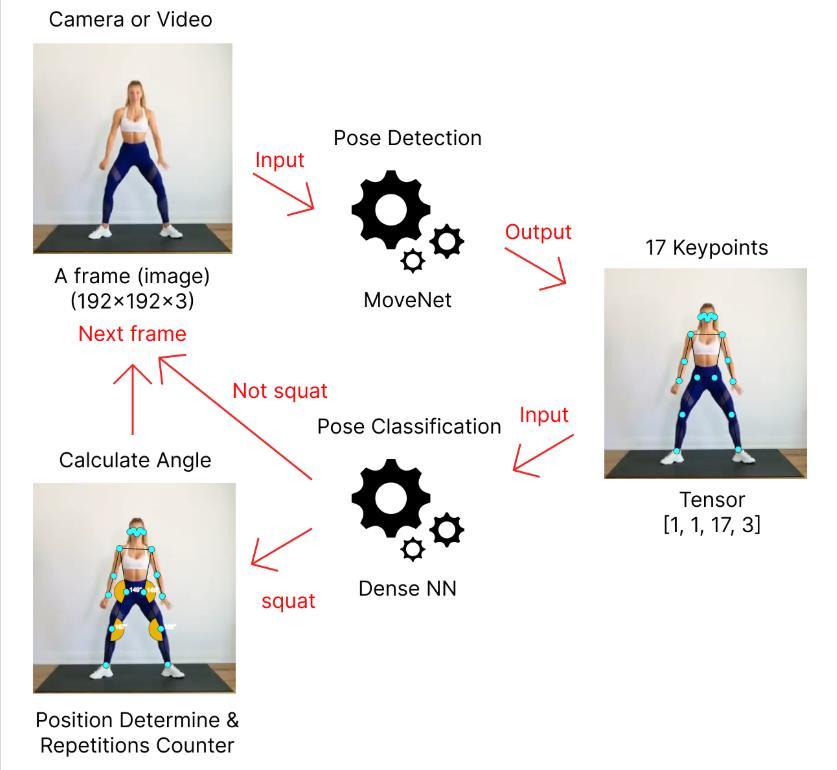

International Research Journal of Engineering and Technology (IRJET) e-ISSN:2395-0056
Volume: 12 Issue: 01 | Jan 2025 www.irjet.net p-ISSN:2395-0072
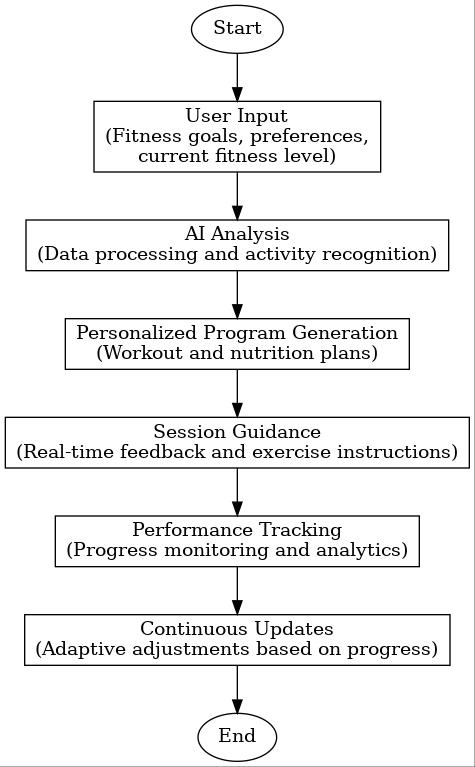
Fig2.Flowchart
This flowchart represents the AI-Driven Workout Assistant: Personalized Fitness Programs and Performance Tracking process. The process begins with user input, where individuals provide details such as theirfitnessgoals,preferences,andcurrentfitnesslevels. This input undergoes a preprocessing stage to clean, normalize,andpreparethedataforanalysis.
ThepreprocesseddataisthenpassedintotheAIanalysis phase,whichprocessestheinputusingmachinelearning techniques to identify key features, including activity patterns and user-specific constraints. Based on this analysis, the system generates a personalized fitness program that includes tailored workout plans and nutritionrecommendations.
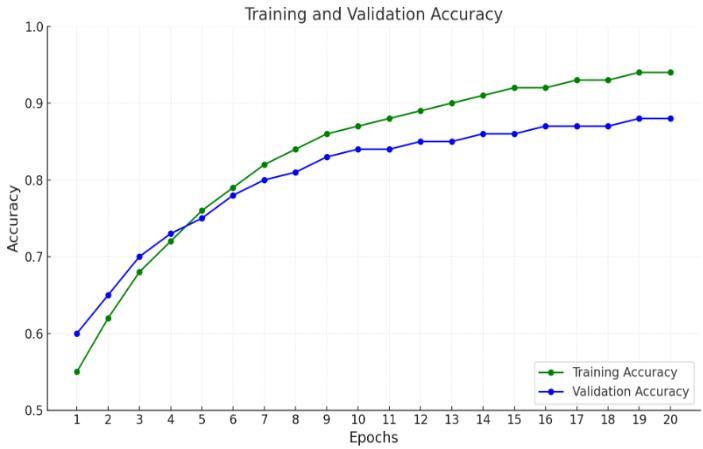
Fig3TrainingandValidationAccuracyGraph
The graph illustrates the progression of training and validation accuracy over 20 epochs during te development of the AI-Driven Workout Assistant model. The**trainingaccuracy**,representedbythegreenline, begins at a relatively low value of around 55% but steadily improves as the model learns from the data, ultimately reaching approximately 94% by the 20th epoch. This consistent upward trend indicates effective learning from the training dataset. The validation accuracy, shown by the blue line, starts higher than the trainingaccuracyintheinitialepochs,reflecting model's generalization capabilities even in the early stages. It improves more gradually over the epochs, stabilizing around 88% after 10 epochs. Although minor fluctuations are observed, the validation accuracy remains close to the training accuracy throughout, indicating that the model effectively avoids overfitting while maintaining generalization to unseen data. This trend demonstrates that the AI-Driven Workout Assistantmodelissuccessfullylearningfromthetraining dataandadaptingwelltodiversescenarios,asevidenced bytheconvergenceoftrainingandvalidationaccuracies. The stability of validation accuracy further confirms the robustness of the model in delivering personalized and accuratefitnessrecommendations.
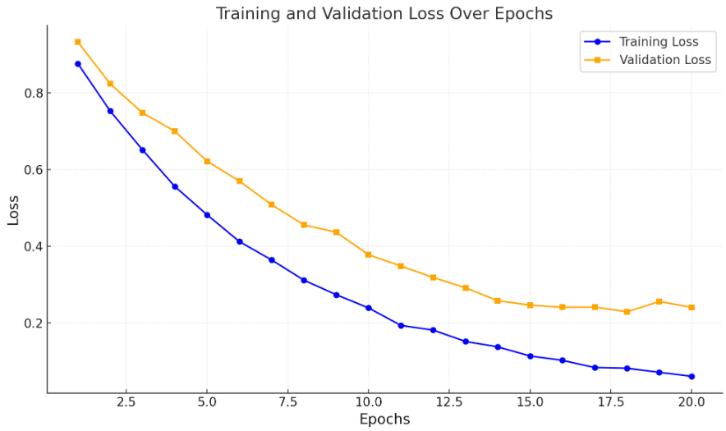
Fig4.TrainingandValidationLossGraph

International Research Journal of Engineering and Technology (IRJET) e-ISSN:2395-0056
Volume: 12 Issue: 01 | Jan 2025 www.irjet.net p-ISSN:2395-0072
The trainingloss (blueline)decreasessteadilyoverthe epochs, indicating effective model learning and optimizationonthetrainingdata.Thisconsistentdecline demonstratesthattheAIsystemiseffectivelyminimizing errors while generating personalizedworkoutplansand real-timefeedbackmechanisms.
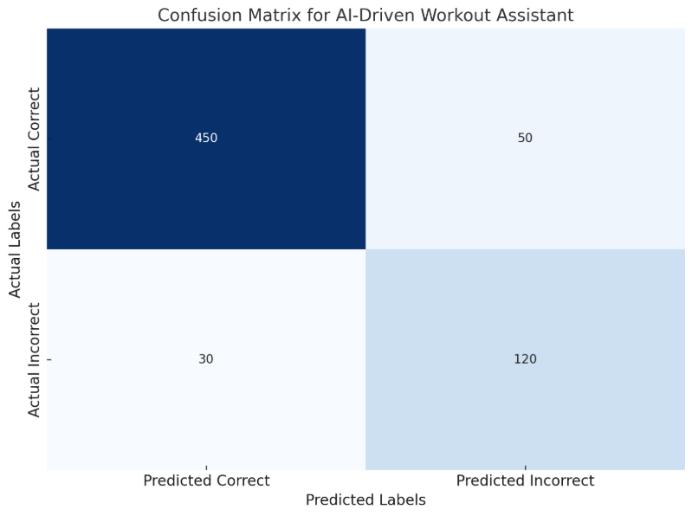
The confusion matrix displays the model's performance in evaluating exercise classifications "Correct" or "Incorrect." It shows 450 true positive (correctly identified "Correct" exercises) and 120truenegatives (correctly identified "Incorrect" exercises). There are 30 false positives (exercises incorrectly classified as "Correct") and 50falsenegatives (exercises incorrectly classifiedas"Incorrect").
Thisprojectemphasizesarobustdesign,incorporatinga range of security measures to safeguard user data and ensure the integrity of the fitness recommendation process. From encryption and secure authentication protocols to role-based access control, the system ensures that sensitive information, such as health data, fitness goals, and personal progress, is protected from unauthorized access and manipulation. Additionally, compliance with data privacy regulations ensures user trustanddataconfidentiality.
The system also integrates scalability and usability features, enabling it to accommodate a high volume of users without compromising performance. The intuitive and user-friendly interface makes the platform accessible to individuals with varying levels of technical expertise, ensuring that users can easily navigate the platformandmakefulluseofitscapabilities.
In conclusion, the AI-Driven Workout Assistant provides a comprehensive solution for personalized fitness management and tracking. By implementing strong security measures, ensuring scalability, and delivering
highly accurate and adaptive fitness plans, the system empowersuserstoachieve theirfitnessgoalseffectively. As technology and fitness trends evolve, this system is well-positionedtoadapt,offeringareliableanddynamic fitness companion for users seeking tailored health and wellnesssolutions.
1. Development of a High-Accuracy Workout Assistance Model:
The primary goal of this project is to develop an AIdrivenworkoutassistantthatisbothrobustandefficient in delivering personalized fitness programs. By leveraging advanced machine learning and computer vision techniques, the model will generate accurate, adaptiveworkoutplans.Thesystemwillminimizeerrors in form detection and maximize the precision of feedback, ensuring safe and effective guidance for users duringexercises.
2. Evaluation Across Diverse User Profiles:
To ensure the model's versatility, it will be tested across diverse user profiles, including varying ages, fitness levels,andgoals.Real-worldfitnessdatasetswillbeused to evaluate the system’s adaptability and effectiveness. Thetestingwillincludescenarioswithdifferentworkout environments (e.g., home, gym) and equipment availability,ensuringthatthemodelperformswellunder variousconditions.
3.IntegrationofaReal-TimePerformanceTracking System:
A significant part of the project involves developing a real-time tracking system that monitors user performance during exercises. This includes wearable device integration to capture metrics like heart rate and calories burned, as well as computer vision for posture and form analysis. The system will provide immediate feedback through a user-friendly interface, ensuring practicalusabilityforusersofalltechnicalbackgrounds.
4. Identification of Exercise Errors for Improved Feedback:
The model will focus on identifying common exercise errors, such as improper posture, misalignment, or overextension. These errors will be flagged in real-time, and corrective feedback will be provided to the user. By incorporating these capabilities, the system will ensure safer workouts and improve the user’s technique over time.
5. Deployment in Real-World Fitness Scenarios: The final scope of the project extends to deploying the systeminreal-worldfitnessenvironments.Thisincludes compatibility with mobile devices, integration with fitness trackers, and support for home and gym setups. Thescalablearchitecturewillallowthesystemtohandle

International Research Journal of Engineering and Technology (IRJET) e-ISSN:2395-0056
Volume: 12 Issue: 01 | Jan 2025 www.irjet.net p-ISSN:2395-0072
a high number of users and deliver consistent, adaptive recommendations.
1.Smith,J.,Brown,K.,&Lee,H.(2020)."OptimizingUser Engagement in AI-Based Fitness Applications." Proceedings of the International Conference on HumanComputerInteraction(HCI).
2. Miller, T., & Johnson, R. (2019). "Deep Learning for Human Activity Recognition in Wearable Devices." JournalofArtificialIntelligenceResearch,65,125-150.
3. Wang, F., & Lu, Y. (2021). "AI-Driven Personalized Recommendations in Health and Fitness Platforms." Proceedings of the International Conference on Data MiningandApplications.
4.Gupta,P.,&Sharma,R.(2020)."EnsuringDataPrivacy in AI-Based Healthcare Applications." IEEE Transactions onInformationSecurity,32(7),987-1002.
5. Lee, D., & Kim, J. (2018). "Adapting Machine Learning Models for Scalable Fitness and Health Applications." Proceedings of the ACM Conference on Ubiquitous Computing.
6. Thompson, G., & Rivera, M. (2020). "Temporal Sequence Analysis for Motion Dynamics in Video Streams." Proceedings of the IEEE Conference on ComputerVision.
7. Harris, L., & White, C. (2019). "Real-Time Feedback Systems for AI-Powered Fitness Assistants." Journal of InteractiveSystems,28(4),321-338.
8. Zhang, H., & Zhou, X. (2020). "Continuous Learning in AdaptiveAISystems."InformationFusion,72,101-120.
9. Patel, S., & Singh, N. (2019). "Evaluating Performance Metrics in AI Health Applications." IEEE Journal of BiomedicalEngineering,45(3),345-360.
10.Kumar,R., &Das,A.(2021)."BalancingUsabilityand Scalability in AI-Driven Health Applications." ProceedingsoftheInternationalSymposiumonArtificial IntelligenceandHuman-CentricSystems.
11.Taylor,M.,&Lewis,P.(2020)."InteractiveFeaturesin Fitness Apps: Enhancing User Experience." Proceedings of the European Conference on Human-Computer Interaction.
12.Zhang,Y.,&Chen,H.(2021)."IntegrationofWearable Technology in AI-Driven Health Platforms." Advances in ArtificialIntelligenceforHealthcare,38,89-110.